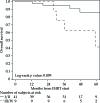High precision radiotherapy including intensity-modulated radiation therapy and pulsed-dose-rate brachytherapy for cervical cancer: a retrospective monoinstitutional study
- PMID: 31969909
- PMCID: PMC6964350
- DOI: 10.5114/jcb.2019.90478
High precision radiotherapy including intensity-modulated radiation therapy and pulsed-dose-rate brachytherapy for cervical cancer: a retrospective monoinstitutional study
Abstract
Purpose: To analyse the survival outcomes and toxicity profile of patients treated with pulsed-dose-rate (PDR) brachytherapy (BT) after intensity-modulated radiation therapy (IMRT) for uterine cervical cancer in a single institution.
Material and methods: Between March 2011 and December 2014, 50 patients with histologically proven stages IB1-IVB cervical cancer were treated with IMRT followed by PDR-BT boost. Radiation treatment consisted of IMRT to pelvic with or without paraaortic lymph nodes to a total dose of 45-50.4 Gy. Weekly concomitant chemotherapy was administered to 45 patients. PDR-BT boost was delivered with a median dose of 30 Gy to the high-risk clinical target volume (HR-CTV) after a median time of 14 days since IMRT. Acute and late toxicity were evaluated by Radiation Therapy Oncology Group (RTOG) - European Organization for Research and Treatment of Cancer (EORTC) scoring criteria and Subjective Objective Management Analytic-Late Effects of Normal Tissues (SOMA-LENT) criteria.
Results: Two patients had tumour persistence at 6 months after the end of BT. After a median follow-up of 33 months, 6 distant metastases with or without regional relapse were observed. The 1- and 5-year progression-free survival was 83% (95% CI: 69-91%) and 76% (95% CI: 61-86%), whereas the 3- and 5-year overall survival was 91% (95% CI: 78-97%) and 76% (95% CI: 56-88%), respectively. Urinary and rectal toxicity higher than grade 2 was observed in 6.3% and 17% of patients, respectively. Five patients (10.6%) had grade 4 gastrointestinal toxicity requiring colostomy.
Conclusions: Our study confirms that the combination of IMRT and PDR-BT can be considered an effective treatment for cervical cancer, ensuring high local control, despite the high percentage of locally advanced disease.
Keywords: IMRT; PDR; brachytherapy; cervical cancer.
Copyright © 2019 Termedia.
Figures
Similar articles
-
High-dose-rate brachytherapy boost for locally advanced cervical cancer: Oncological outcome and toxicity analysis of 4 fractionation schemes.Clin Transl Radiat Oncol. 2021 Nov 6;32:15-23. doi: 10.1016/j.ctro.2021.10.005. eCollection 2022 Jan. Clin Transl Radiat Oncol. 2021. PMID: 34816022 Free PMC article.
-
Proof of principle: Applicator-guided stereotactic IMRT boost in combination with 3D MRI-based brachytherapy in locally advanced cervical cancer.Brachytherapy. 2014 Jul-Aug;13(4):361-8. doi: 10.1016/j.brachy.2014.02.003. Epub 2014 Mar 18. Brachytherapy. 2014. PMID: 24656732
-
Clinical efficacy and toxicity of radio-chemotherapy and magnetic resonance imaging-guided brachytherapy for locally advanced cervical cancer patients: A mono-institutional experience.Acta Oncol. 2015;54(9):1558-66. doi: 10.3109/0284186X.2015.1062542. Epub 2015 Sep 25. Acta Oncol. 2015. PMID: 26406152
-
Three-dimensional intensity-modulated radiotherapy in the treatment of nasopharyngeal carcinoma: the University of California-San Francisco experience.Int J Radiat Oncol Biol Phys. 2000 Oct 1;48(3):711-22. doi: 10.1016/s0360-3016(00)00702-1. Int J Radiat Oncol Biol Phys. 2000. PMID: 11020568
-
Intensity-modulated radiation therapy for the treatment of oropharyngeal carcinoma: the Memorial Sloan-Kettering Cancer Center experience.Int J Radiat Oncol Biol Phys. 2006 Feb 1;64(2):363-73. doi: 10.1016/j.ijrobp.2005.03.006. Epub 2005 May 31. Int J Radiat Oncol Biol Phys. 2006. PMID: 15925451
Cited by
-
Stereotactic Body Radiation Therapy Boost in Patients With Cervical Cancer Ineligible for Brachytherapy.Cancer Diagn Progn. 2021 May 3;1(2):53-60. doi: 10.21873/cdp.10008. eCollection 2021 May-Jun. Cancer Diagn Progn. 2021. PMID: 35403131 Free PMC article.
-
Targeting CDCP1 boost CD8+ T cells-mediated cytotoxicity in cervical cancer via the JAK/STAT signaling pathway.J Immunother Cancer. 2024 Oct 24;12(10):e009416. doi: 10.1136/jitc-2024-009416. J Immunother Cancer. 2024. PMID: 39455095 Free PMC article.
References
-
- Small W Jr, Bacon MA Bajaj A, et al. . Cervical cancer: A global health crisis. Cancer 2017; 123: 2404-2412. - PubMed
-
- Tanderup K, Eifel PJ, Yashar CM et al. . Curative radiation therapy for locally advanced cervical cancer: brachytherapy is not optional. Int J Radiat Oncol Biol Phys 2014; 88: 537-539. - PubMed
-
- Karlsson J, Dreifaldt AC, Mordhorst LB, Sorbe B. Differences in outcome for cervical cancer patients treated with or without brachytherapy. Brachytherapy 2017; 16: 133-140. - PubMed
-
- Holschneider CH, Petereit DG, Chu C et al. . Brachytherapy: A critical component of primary radiation therapy for cervical cancer: From the Society of Gynecologic Oncology (SGO) and the American Brachytherapy Society (ABS). Brachytherapy 2019; 18: 123-132. - PubMed
-
- Naik A, Gurjar OP, Gupta KL et al. . Comparison of dosimetric parameters and acute toxicity of intensity-modulated and three-dimensional radiotherapy in patients with cervix carcinoma: A randomized prospective study. Cancer Radiother 2016; 20: 370-376. - PubMed





